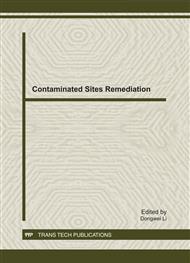p.156
p.161
p.166
p.172
p.179
p.186
p.191
p.198
p.203
Study on the Relationship between Contamination Distribution and Sampling Density
Abstract:
Use some contaminated site (D-block) in Chongqing of China as the experiment site, this paper studies effects of different sampling density (layout grid spacing) on the contaminated area and determination of contaminated boundary in system layout method of environmental monitoring, and then discusses the relationship between sampling density and contaminated distribution in system layout method according to the experiment result. The experiment result indicates that: in a certain range, increase the sampling density, contamination distribution will be more accurate; too big sampling density is not practical; for the common sites with unknown or large-range contaminated distribution, 10m×10m is the recommended layout sampling density.
Info:
Periodical:
Pages:
179-185
Citation:
Online since:
December 2011
Authors:
Price:
Сopyright:
© 2012 Trans Tech Publications Ltd. All Rights Reserved
Share:
Citation:


